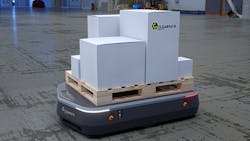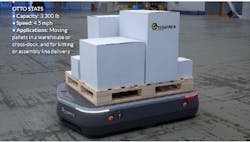Self-Driving Robots: Material Handling May Never Be the Same Again
A swarm of robots will soon be overtaking John Deere’s Horicon, Wis., plant.
Sometime this year, a fleet of new-generation AGVs will begin zipping through the lanes of the company’s assembly line, hauling parts and materials across the plant in an efficient, automated buzz.
On the face of it, there is nothing too exciting about this news. Automated Guided Vehicles are nothing new to the market; they have been scurrying around plants in one form or another for decades already.
But none of them have ever been quite like these.
John Deere’s fleet will mark the latest deployment of OTTO 1500—a fully self-driving, autonomous robotic vehicle built by a new player in the space, Ontario-based Clearpath Robotics.
The machines are capable of transporting up to 3,000 lb of goods through congested plant and warehouse environments without the need for drivers, supervision, or guidance infrastructure.
That last detail is what makes this technology exciting.
Traditional AGVs require a lot of work and a lot of free space to run safely and efficiently. In the past, this has meant tying them to magnetic strips or grids of barcodes crisscrossing human-free transport lanes.
But not anymore.
According to Clearpath co-founder and CEO, Matt Rendall, OTTO taps into the same sensor-driven, high-computing backbone of Google’s self-driving car to safely and efficiently transport supplies along the same plant and warehouse paths populated by workers and equipment.
“The key difference between OTTO and previous generations of this technology is that fundamentally OTTO is off the track,” explains Rendall.
He likens the distinction to the difference between subway systems and taxis in a busy city.
“There is a time and a place for a subway system,” he says. “But when speed and efficiency are needed, there is also a time and a place for taxi cabs.”
However, creating a robot smart enough to safely traverse a busy plant is a far cry from trusting an experienced driver to get you to the office on time. To make that jump, Clearpath had to tap into the full arsenal of today’s technological tools.
A High-Tech Backbone
The biggest story in the AGV market in recent years was Amazon’s 2012 purchase of Kiva Systems.
The $775 million deal gave Amazon exclusive access to Kiva System’s line of warehousing robotics—at the time considered to be one of the most advanced in the market—and eventually deploying 15,000 of them to streamline, upset, and in all ways redefine its complex order picking and delivery process.
According to Rendall, Kiva’s unique, extremely efficiency system was years ahead of its time when it was conceived and built 13 years ago.
However, he notes, the technological tools at the disposal of contemporary robot makers have changed dramatically since then.
“Vehicles like these require 2D barcodes on the floor at approximately three-foot intervals,” he explains. “So if you wanted to enable 100,000 sq ft of fulfillment, you would also need to deploy 100,000 sq ft of barcodes.”
On top of that, he adds, those systems aren’t safe for collaboration with humans. Together, this means the systems require a lot of unpopulated space and a lot of infrastructure to even get started.
The sweet spot of that generation of device, Rendall says, is in greenfield spaces—brand new warehouses and facilities that can be custom-built with the space and infrastructure they require.
However, that is not a luxury most would-be users can afford.
More to the point, it is no longer necessary.
“The technology landscape has fundamentally changed in the last 13 years,” Rendall argues. “Smarphones, the Internet, cloud computing, the Industrial Internet of Things—these are all of the enabling pillars that come together in this beautiful way to make self-driving vehicles possible for manufacturing and for warehousing.”
Computational power alone, he says, has increased exponentially in this time.
“It all starts with computation. We’re able to build a vehicle that has much more powerful machine computation ability than you could have done 10 years ago, 13 years ago, for the same price,” he explains. “That means you’re able to do much more intensive algorithms onboard the robot.”
And that’s the key to the self-driving puzzle: the robot is smart enough to make critical decisions itself. Thanks to the high-tech backing it inherited from Google and the consumer technology industry, OTTO carries with it all of the sensors, computers, and internal logic capabilities to effectively plot courses, avoid obstacles, and safely interact with human coworkers in a way no other AGV has ever mastered.
By going off the track and off the barcode grid, it is able to access whole new aspects of the manufacturing process.
“When you remove those barcodes, you enable the ability to operate in close proximity to humans,” Rendall explains. “This means you can not only do brownfield fulfillment, you can also do brownfield manufacturing.
“You can get deeper into the warehouse, or deeper into the factory than ever before.”
The Human-Robot Trust Fall
From an operations perspective, having a fleet of pilot-less robots carting pieces and parts along an optimized path through the assembly floor sounds like a dream come true. For the workers on that floor, however, that scenario can be a bit more alarming.
“We built OTTO to go anywhere in the factory as long as it ended up in the right location in the most optimal way possible,” Rendall explains. “That led to behavior in the robots that to an uneducated bystander seemed erratic. And the last thing you want to do if you’re trying to build trust is to exhibit erratic behavior.”
To face that challenge, Clearpath has spent much of the last year developing OTTO’s system with user trust in mind.
“The world of human/robot interactions is not very defined or well-understood domain,” Rendall says. “So we’ve invested quite a bit of time building our own place in it.”
That work starts with the vehicle design.
OTTO is equipped with headlights in the front, tail lights in the back, even fit with white backup lights and alarms for reversing. It also has been programmed to do some very predictable things like pass on the right and give pedestrians the right of way.
In other words, Clearpath designed OTTO to look and act in the factory just like a manned vehicle would look and act on the road.
“We tried to codify behaviors and expectations that fit directly with what people already know and expect,” Rendall explains. “We really want to build upon what people know and love because we want to make that learning curve, that socialization, as short or as fast as possible.
The next part of the challenge comes down to training and experience
In this case, designing for industrial automation gave Clearpath a big advantage.
“On public roads, you need to build your system to be robust enough to protect against a child jumping out from between two cars chasing a ball in foggy conditions,” Rendall says. “In a factory, though, people are trained how to be safe. They already know how to interact with fork trucks and production equipment.”
OTTO, he says, fits directly into that knowledge base.
“There’s a level of care that you can expect from people that interact with heavy machinery,” he says. “We start with that and then train the material flow engineers, the shift supervisors, and the floor staff so they can understand what safe operating procedures are around the robots.”
The Power of Innovation
Looking at OTTO objectively, it’s safe to call this an extremely exciting innovation. After all, if self-driving factory robots aren’t a harbinger of an amazing sci-fi future, nothing is.
But what is more exciting is the speed at which Clearpath brought this technology to market.
Clearpath Robotics began in the dorms at Ontario’s University of Waterloo by a group of robot hobbyists and mechatronics engineering majors, just in 2008.
Since then, the company has experimented with a few self-driving military drones and vehicles—include a minefield-clearing concept that provided the company with its name.
The company didn’t sell its 1,000th robot until 2014, and until 2015 it hadn’t targeted any robots at all for the manufacturing and material handling space.
And yet in 2016, Clearpath is already on the market with a fully robust, smart machine that is getting ready to some very heavy lifting at a few of the country’s top manufacturers.
That seems like an incredible feat. And it is. But it is exactly the kind of innovation we should expect in today’s tech-rich, tech-obsessed environment.
“We knew going into this that we weren’t experts in supply chain or manufacturing optimization from a material flow planning perspective, and we had no misillusions about that,” Rendall explains.
But, he says, they did understand robotics and they had plenty of experience playing in the tech space that surrounds it. And that, he says, is enough to build just about anything.
“The way that I think about it is, the fundamental pillars that have enabled self-driving vehicles for factories are computing, which led into mobile computing and smartphones, and then Internet which hooks that into big data and predictive analytics,” he says. “All you need then is an investment in robotics and unmanned vehicles.”
In essence, he is describing an environment that it ripe with the raw ingredients for innovation. The consumer world is pumping out smart devices, powerful and cheap sensors, and incredible IoT innovations that, to date, still have no direct market in the consumer world.
However, facing unprecedented need for higher productivity, improved logistics efficiency, and manufacturing proficiency, the industrial world presents a desperate and legitimate need for smart technologies.
There is that old mandate in the manufacturing world: do more, better, with less. That has been the reigning principle in the industry for generations, and it’s not showing any sign of easing. It is, in fact, only getting more extreme.
Tapping into the right combination of the full and already robust technological landscape surrounding manufacturing—all of the modern Internet capabilities, cloud computing, robotics, smartphones, and sensors—can arm manufacturers with exactly what they need to win this fight.
And it looks like they are starting to win.
“Unless you spend a lot of time in [Google’s self-driving test grounds] Mountainview, Calif., you’ve probably never seen a self-driving vehicle on the road,” Rendall says. “What I’m most excited about is that people will see self-driving vehicles in factories much sooner than they will ever see them on the road.”
About the Author
Travis Hessman
VP of Content, Endeavor Business Media
Travis Hessman is the VP of Content for Endeavor Business Media. Previously, Travis was the Editor-in-Chief for Industry Week and New Equipment Digest as well as the Group Editorial Director for Endeavor's Manufacturing Group.
He began his career as an intern at IndustryWeek in 2001 and later served as IW's technology and innovation editor. Today, he combines his experience as an educator, a writer, and a journalist to help address some of the most significant challenges in the manufacturing industry, with a particular focus on leadership, training, and the technologies of smart manufacturing.



